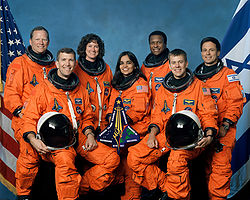Michael Philip Anderson
| Michael Philip Anderson | |
|---|---|
 |
|
| NASA Astronaut | |
| Nationality | American |
| Status | Deceased |
| Born | December 25, 1959 Plattsburgh, New York, United States |
| Died | Over Texas |
| Previous occupation | Scientist |
| Rank | Lieutenant Colonel, USAF |
| Time in space | 24d 18h 08m |
| Selection | 1994 NASA Group |
| Missions | STS-89, STS-107 |
| Mission insignia | |
Michael Philip Anderson (December 25, 1959 – February 1, 2003) was a United States Colonel (USAF) and NASA astronaut, who was killed in the Space Shuttle Columbia disaster when the craft disintegrated after reentry into the Earth's atmosphere.
Anderson was born in Plattsburgh, New York, but considered Spokane, Washington to be his hometown.
Contents |
Education
- 1977: Graduated from Cheney High School in Cheney, Washington.
- 1981: Bachelor of science degree in physics/astronomy from University of Washington.
- 1990: Master of science degree in physics from Creighton University.
Special honors
- Distinguished graduate USAF Communication Electronics Officers course
- Recipient of the Armed Forces Communication Electronics Association (AFCEA) Academic Excellence Award, 1983
- Received the USAF Undergraduate Pilot Training Academic Achievement Award for Class 87-08 Vance AFB
Experience
Anderson graduated from the University of Washington in 1981 and was commissioned a second lieutenant. After completing a year of technical training at Keesler AFB Mississippi he was assigned to Randolph Air Force Base, Texas. At Randolph he served as Chief of Communication Maintenance for the 2015 Communication Squadron and later as Director of Information System Maintenance for the 1920 Information System Group.
In 1986 he was selected to attend Undergraduate Pilot Training at Vance Air Force Base, Oklahoma. Upon graduation he was assigned to the 2nd Airborne Command and Control Squadron, Offutt Air Force Base, Nebraska as an EC 135 pilot, flying the Strategic Air Command's airborne command post code-named “Looking Glass”.
From January 1991 to September 1992 he served as an aircraft commander and instructor pilot in the 920th Air Refueling Squadron, Wurtsmith Air Force Base, Michigan.
From September 1992 to February 1995 he was assigned as an instructor pilot and tactics officer in the 380 Air Refueling Wing, Plattsburgh Air Force Base, New York.
Anderson logged over 3000 hours in various models of the KC-135 and the T-38A aircraft.
NASA experience
Selected by NASA in December 1994, Anderson reported to the Johnson Space Center in March 1995. He completed a year of training and evaluation, and was qualified for flight crew assignment as a mission specialist. Anderson was initially assigned technical duties in the Flight Support Branch of the Astronaut Office. Anderson flew on STS-89 and STS-107, logging over 593 hours in space.
Space flight experience
STS-89 Endeavour (January 22–31, 1998), was the eighth Shuttle-Mir docking mission during which the crew transferred more than 9,000 pounds of scientific equipment, logistical hardware and water from the Space Shuttle to Mir. In the fifth and last exchange of a U.S. astronaut, STS-89 delivered Andy Thomas to Mir and returned with David Wolf. Mission duration was 8 days, 19 hours and 47 seconds, traveling 3.6 million miles in 138 orbits of the Earth.
STS-107 Columbia (January 16 to February 1, 2003). The 16-day flight was a dedicated science and research mission. Working 24 hours a day, in two alternating shifts, the crew successfully conducted approximately 80 experiments. The STS-107 mission ended abruptly on February 1, 2003 when Space Shuttle Columbia and his crew perished during entry, 16 minutes before scheduled landing. Mission duration was 15 days, 22 hours and 20 minutes.
Quotes
Prior to the final launch of the Columbia, Anderson stated: "There's always that unknown."
Awards
Qualification insignia
- USAF Master Astronaut
Personal decorations
- Defense Distinguished Service Medal †
- Defense Superior Service Medal
- Meritorious Service Medal
- Air Force Achievement Medal with oak leaf cluster (2 awards)
- Congressional Space Medal of Honor †
- NASA Distinguished Service Medal †
- NASA Space Flight Medal †
- National Defense Service Medal
The † symbol indicates a posthumous award.
Tributes

- State Route 904, running through Cheney, Washington, where he graduated from high school, was renamed in his memory.
- Asteroid 51824 Mikeanderson was posthumously named after Anderson.
- Anderson Hall, in the Columbia Village apartments, at the Florida Institute of Technology is named after him.
- Anderson Plaza, the green space in front of the Hixson-Lied Science Center at Creighton University was named after him in a compromise between the student body, who wanted the Science Center named for Anderson, and the administration who had already sold the naming rights to the Hixson-Lied family.
- Blair Elementary School on Fairchild Air Force Base was renamed Anderson Elementary School in his honor.
- Avondale Elementary School in Avondale, Arizona was renamed Michael Anderson Elementary in his honor. He attended school there when he was in 3rd grade and one of the school T-shirts was aboard the Columbia on its last voyage.
- Anderson Park in Canton, Mississippi was dedicated in June 2004.
See also
- List of African-American astronauts
- Space Shuttle Columbia disaster
- Space science
References
External links
- NASA biography
- Michael Anderson STS-107 Crew Memorial
- Florida Today - Florida Tech dedicates dorms to Columbia 7 - October 29, 2003
- The Chicago Alliance for Minority Participation Keynote Address by Major Michael P. Anderson
- Spacefacts biography of Michael P. Anderson
|
|||||||||||||||
|
||||||||||||||||||||
|
||||||||

